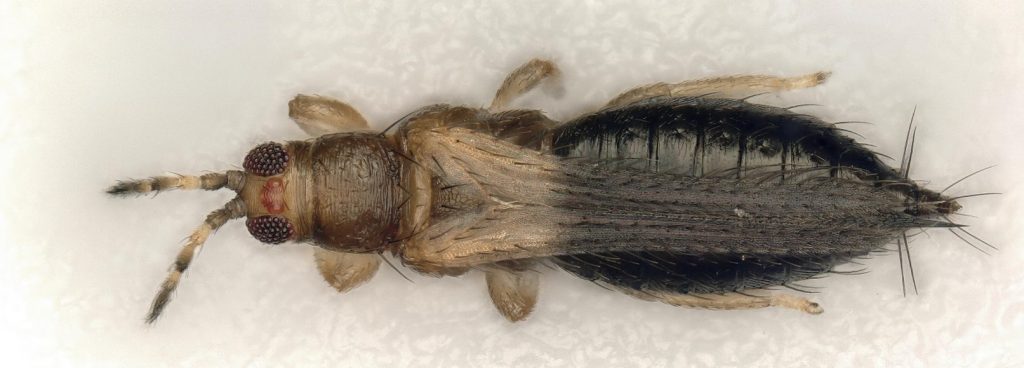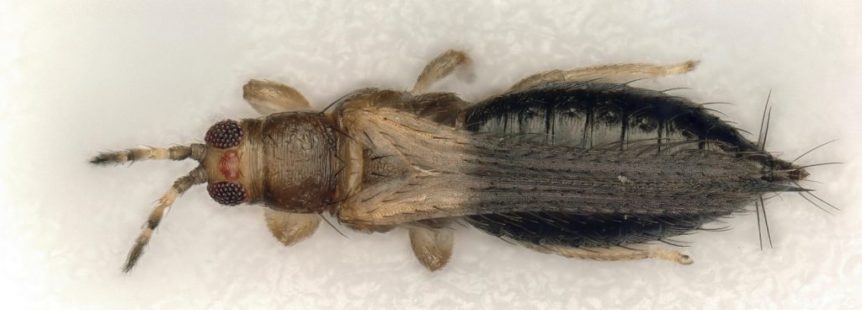
The invasive thrips parvispinus is a tiny, elusive insect that has spread across Florida with a growing appetite for various fruit, vegetable and ornamental crops.
Since it first emerged in a central Florida greenhouse in 2020, the pest has caused significant damage to various industries and even spread to residential areas. In South Florida, the gardenia and mandevilla production industries experienced major losses, while others impacted that grow around the state include pepper varieties, hibiscus, Mexican petunias, ixoras, anthuriums, hoyas and scheffleras.
A University of Florida scientist at the Institute of Food and Agricultural Sciences (UF/IFAS) in South Florida has published a milestone study in the journal Insects, providing growers, entomologists and landscape companies with promising products that can be used to battle this pest.
“There are many products registered for thrips control that can be used in ornamental production,” said Alexandra Revynthi, an assistant professor of ornamental entomology and acarology at the UF/IFAS Tropical Research and Education Center in Homestead and the principal investigator. “This study narrows the list of products down and offers a few environmentally friendly options to minimize environmental impact.”
Revynthi has led research and several workshops to update industries on the latest studies and treatments available.
What Works?
The study produced a list of conventional and biorational insecticides – pesticides made with natural compounds that pose minimal risk to beneficial organisms when direct contact between the product and the arthropod is avoided — and that can be used against thrips parvispinus. To avoid insecticide resistance, growers must rotate the insecticides, said Revynthi.
While no formal economic studies exist on the impact of the thrips parvispinus, since 2020, some growers reported estimates of their financial losses attributable to this pest ranging from several hundred thousand to a million dollars, not including the cost of managing the pest, she said.
“I hope that by identifying several efficacious treatments, the growers will have more tools in their hands to battle this pest and minimize its financial impact,” she said.
Surveying Growers
To identify the chemical control treatments, Revynthi and her team used critical information gathered from growers and asked questions.
They started with anecdotal evidence from the growers indicating which conventional chemistry often used for thrips control was not effective against this pest. They screened 32 registered products for use in ornamental plants for thrips control that are available in the Florida market and evaluated 21 conventional and 11 biorational insecticides.
“Since we knew the two larval stages as well as the adults can cause damage to plants, we decided to evaluate all the products against these three stages,” she said.
Scientists also addressed whether they could treat an infestation or potentially prevent it altogether.
“To investigate whether we can treat an infestation, we applied the insecticides directly on the thrips, to explore whether we could prevent an infestation. We exposed the thrips to plant tissue that was previously sprayed with one of the insecticides,” she said.
The results indicate several products could be good options to consider.
“These products can either kill the thrips immediately, within 48 hours, or they can prevent them from feeding,” said Revynthi. “Since this was a laboratory study, the results are still pending validation from greenhouse experiments.”
Upcoming Workshop
To provide detailed information on the findings for growers, landscape companies and entomologists, a free workshop is scheduled on Feb. 27, from 9:30 a.m. to 11:30 a.m. The workshop will take place at the UF/IFAS Extension Miami-Dade County auditorium, at 18710 SW 288th St., Homestead, Fla. For more information, please contact Qingchun Liu, commercial horticulture agent, at q.liu1@ufl.edu or 305-248-3311.
Research funding and support for this study was made possible the Florida Nursery, Growers and Landscape Association – Miami Dade Chapter, the Dade County Farm Bureau, Dade County Agri Council, the National Horticulture Foundation, and the University of Florida-USDA-ARS Non-Assistance Cooperative Agreement.










